More languages
More actions
Verda.Majo (talk | contribs) (added some info about churches and mosques in pyongyang) Tag: Visual edit |
m (→Churches) Tag: Visual edit |
||
| (12 intermediate revisions by 2 users not shown) | |||
| Line 1: | Line 1: | ||
[[File:Opening ceremony of residential area on Ryomyong Street in Pyongyang.jpg|thumb|People gather for the opening ceremony of a newly constructed residential area on Ryomyong Street in Pyongyang on April 13, 2017.]] | [[File:Opening ceremony of residential area on Ryomyong Street in Pyongyang.jpg|thumb|People gather for the opening ceremony of a newly constructed residential area on Ryomyong Street in Pyongyang on April 13, 2017.]] | ||
[[File:Pyongyang at night.png|thumb|Pyongyang at night]] | |||
'''Pyongyang''' (Korean: 평양시; Hanja: 平壤市) is the capital of the [[Democratic People's Republic of Korea]]. Pyongyang is located on the [[Taedong River]] about 109 km (68 mi) upstream from its mouth on the [[Yellow Sea]]. Pyongyang is a directly administered city with equal status to the provinces of DPRK. | '''Pyongyang''' (Korean: 평양시; Hanja: 平壤市) is the capital of the [[Democratic People's Republic of Korea]]. Pyongyang is located on the [[Taedong River]] about 109 km (68 mi) upstream from its mouth on the [[Yellow Sea]]. Pyongyang is a directly administered city with equal status to the provinces of DPRK. | ||
| Line 7: | Line 8: | ||
== History == | == History == | ||
The ancient capital of the legendary Dangun dynasty (2333 BCE) was located on the site where, according to legend, the modern city of Pyongyang was founded in 1122 BCE.<ref name=":0" /> Pyongyang has been the capital of two ancient Korean kingdoms, Gojoseon and Goguryeo, and served as the secondary capital of Goryeo. | The ancient capital of the legendary Dangun dynasty (2333 BCE) was located on the site where, according to legend, the modern city of Pyongyang was founded in 1122 BCE.<ref name=":0" /><ref name=":7">[https://www.youngpioneertours.com/pyongyang-ultimate-guide/ “The Ultimate Pyongyang Guide.”] ''Young Pioneer Tours'', Accessed 10 Apr. 2023. [https://web.archive.org/web/20230323043750/https://www.youngpioneertours.com/pyongyang-ultimate-guide/ Archived] 2023-03-23.</ref> Pyongyang has been the capital of two ancient Korean kingdoms, Gojoseon and Goguryeo, and served as the secondary capital of Goryeo. | ||
In the 1890s, Pyongyang was the site of the Battle of Pyongyang, during the invasion that eventually led to Japanese colonial rule. During the colonial rule of the Japanese, Pyongyang became increasingly industrialized.<ref name=":7" /> | |||
[[File:Pyongyang after U.S. Air Force bombing.jpg|thumb|Pyongyang after U.S. bombing.]] | |||
=== Korean War === | === Korean War === | ||
Pyongyang was devastated during the [[Korean War]], during the sustained aerial bombing by the [[United States of America]]. By the time of the armistice, an estimated 75 percent of Pyongyang's area was destroyed by the bombing campaign, which was part of a broader U.S. bombing effort throughout the country, in which conventional explosives, incendiary bombs, and napalm destroyed nearly all of the country's cities and towns. | Pyongyang was devastated during the [[Korean War]], during the sustained aerial bombing by the [[United States of America]]. By the time of the armistice, an estimated 75 percent of Pyongyang's area was destroyed by the bombing campaign, which was part of a broader U.S. bombing effort throughout the country, in which conventional explosives, incendiary bombs, and napalm destroyed nearly all of the country's cities and towns. | ||
=== Post-war rebuilding === | |||
[[File:Chollima monument at night.jpg|thumb|298x298px|The Chollima monument depicts a legendary extremely fast horse, carrying a worker holding up the "Red Letter" of the Central Committee of the Workers' Party of Korea, and a farmer with a sheaf of rice in her arms. It represents DPRK's Chollima movement of rapid development beginning in 1956.<ref>[https://kfausa.org/chollima-statue/ “Chollima Statue.”] ''KFAUSA.org'', Accessed 10 Apr. 2023.</ref><ref>“The Chollima Statue | North Korea Travel Guide - Koryo Tours.” ''Koryogroup.com'', 29 Jan. 2019, Accessed 10 Apr. 2023.</ref>]] | |||
After the war, DPRK as a whole underwent a period of reconstruction. As Pyongyang was left in near-complete ruin after the war, urban planners were able to design a new structure for the city. Based on a 1953 plan designed by Kim Jung Hee, Pyongyang was planned as a one-million population city that would stretch from the Taedong River to the Potong River, with the density of city being planned as 20-25%. To resolve disparities between cities and to balance development between urban and rural area, the architects of Pyongyang aimed to set aside self-productive units within the city. In present times, Pyongyang continues to be planned based on a unit district system that combines the industrial and residential so that residents can both produce and consume their products.<ref name=":8">Yim, Dongwoo. [https://www.archpaper.com/2017/08/pyongyang-urban-planning-development/ “A Brief Urban History of Pyongyang, North Korea—and How It Might Develop under Capitalism.”] ''The Architect’s Newspaper'', 24 Aug. 2017, accessed 10 Apr. 2023. [https://web.archive.org/web/20230119081706/https://www.archpaper.com/2017/08/pyongyang-urban-planning-development/ Archived] 2023-01-19.</ref> | |||
The design was intended so that Pyongyang be developed in a well-balanced way in contrast to any other capitalist cities in the world. Architects purposefully incorporated landscape features into the city. Both of Pyongyang's riversides were developed into major landscaped areas, and most major boulevards were heavily planted. Additionally, to maximize the effectiveness of labor and production for workers, planners created several leisure parks in the city, so that the public could have enough rest and recover before returning to production. In Pyongyang, most of the leisure parks were located close to historical or memorial areas. Meanwhile, the central part of the city was structured as a place for administrations and institutions. The main square, Kim Il Sung Square, is also located there, while Juche Tower is located directly across the river from the square.<ref name=":8" /> | |||
After the main focus on reconstruction in the 1950s, the architectural strategy of Pyongyang shifted in the 1960s, aiming for the expansion of the major boulevards and the construction of high-rise residential buildings along the boulevards, large-scale civic and cultural facilities, symbolic statues and squares, and including leisurely convenient facilities for foreigners.<ref name=":8" /> The development strategy of DPRK as a whole in this period is known as the [[Chollima movement]].<ref>[https://www.youtube.com/watch?v=jQ88m0RINOY "Rebuilding North Korea | The Chollima Movement EXPLAINED."] DPRK Explained. YouTube. March 25, 2023. [https://web.archive.org/web/20230401112301/https://www.youtube.com/watch?v=jQ88m0RINOY&list=WL&index=4 Archived] 2023-04-01.</ref> | |||
== Educational institutions == | == Educational institutions == | ||
Pyongyang is the location of numerous universities and educational facilities specializing in various fields of study and training. | |||
=== Universities === | |||
[[File:Kim Chaek University of Technology students at the 2019 International Collegiate Programming Contest.jpg|thumb|Kim Chaek University of Technology students at the 2019 International Collegiate Programming Contest.]] | |||
[[Kim-Il Sung University]] (Korean: 김일성종합대학; Hanja: 金日成綜合大學) was founded in 1946, soon after independence. It is DPRK's top university and includes a full range of faculties from the sciences to the arts and social sciences. During the war it was temporarily relocated to a site near Pyongsong City. Kim-Il Sung University hosts approximately 100 exchange students a year, the majority from [[People's Republic of China|China]].<ref>[https://tongiltours.com/travel-guide/pyongyang/attractions/kim-il-sung-university “North Korea Travel Guide | Pyongyang Attractions | Kim Il Sung University.”] 2018. Tongil Tours. January 8, 2018. </ref> | |||
[[Kim Chaek University of Technology]] (Korean: 김책공업종합대학; Hanja: 金策工業綜合大學) is one of DPRK's top technical universities. It has also been taking part in the International Collegiate Programming Contest for several years. It usually scores in the top 20. The university ranked in 8th position in the 2019 contest, which was held in [[Portuguese Republic|Portugal]]. In doing so, it ranked ahead of [[Beijing University|Beijing]] and [[Tsinghua University|Tsinghua Universities]] of China, [[Oxford University|Oxford]] and [[Cambridge University|Cambridge Universities]] of the [[United Kingdom of Great Britain and Northern Ireland|U.K.]], [[Harvard University|Harvard]] and [[Stanford University|Stanford Universities]] of the [[United States of America|U.S.]], and [[Republic of Korea|south Korea]]'s Korea Advanced Institute of Science and Technology (KAIST).<ref>Williams, Martyn. [https://www.northkoreatech.org/2019/05/04/kim-chaek-university-icpc-2019/ “Kim Chaek University Ranks 8th in International Programming Contest.”] ''North Korea Tech - 노스코리아테크'', 3 May 2019, Accessed 9 Apr. 2023. [https://web.archive.org/web/20221005183432/https://www.northkoreatech.org/2019/05/04/kim-chaek-university-icpc-2019/ Archived] 2022-10-05.</ref><ref>Williams, Martyn. [https://www.northkoreatech.org/2019/10/23/science-and-technology-education-in-north-korea-enters-the-21st-century/ “Science and Technology Education in North Korea Enters the 21st Century.”] ''North Korea Tech - 노스코리아테크'', Accessed 9 Apr. 2023. [https://web.archive.org/web/20221203001232/https://www.northkoreatech.org/2019/10/23/science-and-technology-education-in-north-korea-enters-the-21st-century/ Archived] 2022-12-03.</ref> | |||
Kim Hyong Jik University of Education (Korean: 김형직사범대학; Hanja: 金亨稷師範大學) specializes in the training of teachers. Founded in 1946 as Pyongyang Teacher’s College (평양교원대학), its name was changed various times until receiving the current name, named after Kim Hyong Jik, Kim Il Sung’s father, who was a teacher.<ref>[https://tongiltours.com/travel-guide/pyongyang/attractions/kim-hyong-jik-university-of-education “North Korea Travel Guide | Kim Hyong Jik University of Education.”] Tongil Tours. January 8, 2018. [https://web.archive.org/web/20230305043046/https://tongiltours.com/travel-guide/pyongyang/attractions/kim-hyong-jik-university-of-education Archived] 2023-03-5.</ref> | |||
Pyongyang University of Foreign Studies (Korean: 평양외국어대학) offered summer programs to foreigners via [[Tongil Tours]] starting in 2016, offering three-week Korean language immersion courses at the university.<ref>[https://tongiltours.com/pyongyang-summer-language-program “Study in North Korea | Pyongyang Korean Language Program.”] Tongil Tours. June 8, 2019. [https://web.archive.org/web/20230228220122/https://tongiltours.com/pyongyang-summer-language-program Archived] 2023-02-28.</ref> | |||
Pyongyang University of Science and Technology (Korean: 평양과학기술대학) is the first and only privately-run university in DPRK, established via a contract between the Northeast Asia Foundation for Education & Culture and the DPRK Department of Education. The university opened in October 2010 and is located in Jonjin-dong, Rangnang District, Pyongyang. PUST has several foreign faculty members from China, the United States, [[Canada]], the United Kingdom, and other parts of [[Europe]]. The foreign faculty teach in the schools of Agriculture and Life Sciences, Electrical and Computer Engineering, Foreign Languages, and International Finance and Management. The language of education at PUST is English, so all first-year students take intensive English classes to prepare them for participation in their major classes. Chinese is taught as a second foreign language during the third year of the undergraduate program. Since 2011, during October every two years PUST hosts an international conference called the International Conference of PUST (ICoPUST).<ref>[https://pust.co/index.php/about-pust/ “About Us – Pust.co.”] Pust.co. 2019. [https://web.archive.org/web/20220324184124/https://pust.co/index.php/about-pust/ Archived].</ref><ref>PUST. 2016. [https://www.youtube.com/watch?v=bSrzIOPFN5Y “Pust Stories: Mi Hyang.”] YouTube Video. [https://web.archive.org/web/20230323120537/https://www.youtube.com/watch?v=bSrzIOPFN5Y Archived] 2023-03-23.</ref><ref>highersites. 2014. [https://www.youtube.com/watch?v=KnBuzVOaMIw “My Experience at PUST(North Korea)평양과기대에서의 체험(영어).”] YouTube Video. [https://web.archive.org/web/20230323120750/https://www.youtube.com/watch?v=KnBuzVOaMIw Archived] 2023-03-23.</ref> | |||
=== Deaf and Blind Center of Pyongyang === | |||
The Deaf and Blind Centre of Pyongyang is one of various institutions serving deaf and blind people in DPRK, and is located in Moranbong District. It provides specialized education and opportunities to [[deaf]] and [[blind]] students and helps provide employment for deaf and blind adults, while also increasing awareness about people with [[Disability|disabilities]] in DPRK. The center teaches braille and sign language to young students. Deaf and blind students and adults also translate materials into braille and provide sign language videos for educational material to the local intranet and schools throughout the country.<ref name=":5">[https://www.youngpioneertours.com/ypt-deaf-blind-charity/ “YPT Deaf & Blind Charity.”] Young Pioneer Tours. September 25, 2020. [https://web.archive.org/web/20221207101032/https://www.youngpioneertours.com/ypt-deaf-blind-charity/ Archived] 2022-12-07.</ref><ref>Young Pioneer Tours. [https://www.youtube.com/watch?v=KDXqKqJTboA “Pyongyang Centre for the Deaf and Blind.”] YouTube Video. [https://web.archive.org/web/20230323081818/https://www.youtube.com/watch?v=KDXqKqJTboA Archived] 2023-03-23.</ref> | |||
A kindergarten for the deaf is also available in Moranbong District. The project to create the kindergarten was funded by a small [[Federal Republic of Germany|German]] non-profit Disabled Persons Organization.<ref name=":5" /><ref name=":6">[https://www.britishdeafnews.co.uk/deaf-advances-north-korea/ “Deaf Advances in North Korea.”] British Deaf News. September 15, 2016. [https://web.archive.org/web/20230324112400/https://www.britishdeafnews.co.uk/deaf-advances-north-korea/ Archived] 2023-03-24. | |||
</ref> A member of a delegation of the [[World Federation of the Deaf]] who visited the kindergarten described his impression of the kindergarten in a 2016 article for British Deaf News: "[W]e were fortunate to see the great strides made there. It was interesting to see such a rapid progressive model of education and to see how these deaf children were learning Korean Sign Language from teachers who are deaf. [...] It was impressive to see the interaction between the children and the teacher. Colin and I got involved and we had a laugh with them and it proved that when a child has sign language, the world becomes their oyster. They were so animated, it was wonderful."<ref name=":6" /> | |||
=== Grand People's Study House === | |||
[[File:Juche statue at sunset.png|thumb|View of the Grand People's Study House from the bottom of Juche Tower]] | |||
The Grand People's Study House (Korean: 인민대학습당; Hanja: 人民大學習堂) is DPRK's national library, built in 1982. It is located on Kim Il Sung Square, opposite to Juche Tower, with the Taedong River running in between.<ref>[https://tongiltours.com/travel-guide/pyongyang/attractions/grand-peoples-study-house “North Korea Travel Guide | Pyongyang | Grand People’s Study House.”] Tongil Tours. June 23, 2017. [https://web.archive.org/web/20230305043855/https://tongiltours.com/travel-guide/pyongyang/attractions/grand-peoples-study-house Archived] 2023-03-05.</ref> The stated purpose of the library is to be a center of study of the [[Juche|Juche Idea]], science, technology, and the arts. It also serves as correspondence university for continuing education and research. The various rooms include a music room, lecture theatres, and classrooms. Conversational language study sessions are commonly held at this library. Excluding holidays, the Grand People's Study House is open from 09:00 to 18:00 for general browsing. It is open 09:00 to 19:30 for specific lectures and class time with the exception of Saturday, Sunday, and holidays.<ref>[https://koryogroup.com/travel-guide/north-korea-guide-grand-peoples-study-house “Grand People’s Study House | North Korea Travel Guide - Koryo Tours.”] Koryogroup.com. December 27, 2018. [https://web.archive.org/web/20230323121750/https://koryogroup.com/travel-guide/north-korea-guide-grand-peoples-study-house Archived] 2023-03-23.</ref> | |||
== Religious facilities == | == Religious facilities == | ||
There are multiple religious facilities in Pyongyang serving different faiths. Some are recently built while others were built before the war (many of them having to be re-built after the war's devastation). Some facilities cater mainly to Pyongyang's expat communities, while others serve the local community as well as visitors, while others are oriented toward preserving sites of historical or cultural interest. [[Christianity|Christian]] churches include the Protestant Bongsu, Chilgol and Jeil churches, as well as the Catholic Jangchung Cathedral, and the Orthodox Holy Trinity Russian Church. The Ar-Rahman Mosque serves the [[Islam|Muslim]] community of Pyongyang. | There are multiple [[Religion|religious]] facilities in Pyongyang serving different faiths as well as some being preserved historical sites. Some are recently built while others were built before the war (many of them having to be re-built after the war's devastation). Some facilities cater mainly to Pyongyang's expat communities, while others serve the local community as well as visitors, while others are oriented toward preserving sites of historical or cultural interest. [[Christianity|Christian]] churches include the Protestant Bongsu, Chilgol and Jeil churches, as well as the Catholic Jangchung Cathedral, and the Orthodox Holy Trinity Russian Church.<ref name=":2" /> The Ar-Rahman Mosque serves the [[Islam|Muslim]] community of Pyongyang.<ref name=":3" /> Pyongyang also has Kwangbop Temple, a [[Buddhism|Buddhist]] temple that was re-built after the destruction of the war. Today, the temple is managed as a national heritage site according to the national heritage protection policy of the Workers' Party of Korea.<ref name=":4">[https://dprktoday.com/news/57674 “광법사.”] May 15, 2022. DPRK Today. [https://web.archive.org/web/20230323064528/https://dprktoday.com/news/57674 Archive].</ref> | ||
Previously, Pyongyang had so many churches that it was sometimes known as the "Jerusalem of the East". These churches, like nearly everything else in Pyongyang, were annihilated in the Korean War carpet bombing campaigns perpetrated by the USA.<ref name=":1">[https://koryogroup.com/travel-guide/bongsu-church-north-korea-travel-guide “Bongsu Church | North Korea Travel Guide - Koryo Tours.”] Koryogroup.com. May 4, 2020. [https://web.archive.org/web/20230323060104/https://koryogroup.com/travel-guide/bongsu-church-north-korea-travel-guide Archived].</ref> | Previously, Pyongyang had so many churches that it was sometimes known as the "Jerusalem of the East". These churches, like nearly everything else in Pyongyang, were annihilated in the Korean War carpet bombing campaigns perpetrated by the USA.<ref name=":1">[https://koryogroup.com/travel-guide/bongsu-church-north-korea-travel-guide “Bongsu Church | North Korea Travel Guide - Koryo Tours.”] Koryogroup.com. May 4, 2020. [https://web.archive.org/web/20230323060104/https://koryogroup.com/travel-guide/bongsu-church-north-korea-travel-guide Archived].</ref> In the 2014 documentary ''[[People Are The Sky (2014)|People Are The Sky]]'', a member of the congregation at Bongsu Church in Pyongyang spoke about her experience during the U.S. carpet bombing of the DPRK and its impact on the Christian community who suffered from the U.S. attacks:<blockquote>There were many churches on Pyongyang. Actually, because there were so many churches, we called it the second Jerusalem. [...] After we were liberated, the People's Government was established. A lot of churches were born freely. After that we lived in peace. We were able to live in peace for the next five years. [Until the war broke out.] I believe those five years were our golden age. We attended church every week after school. But soon there was no church left because of the heavy bombing. Even during the worship service, the bombing killed a lot of people. When I think of that time, even now tears gather in my eyes. So many of my friends died. Then we heard that the U.S. was planning to drop the [[Nuclear weapon|atomic bomb]]. We were threatened that we would all die and must go south. Because of that threat, a lot of my people headed south. Americans shot those people and killed them. So they killed, largely by bombing but also by shooting. They bombed us even during worship service. No churches were left in Pyongyang! Before the war, we thought Americans were angels from God, but after the war, we hated them.<ref>Extremely Rare DPRK videos. [https://www.youtube.com/watch?v=kfeY6bVQ1nA “North Korean Christian Woman Tells What Happened to Christians in North Korea.”] YouTube Video. Clip from Dai Sil Kim-Gibson's “People Are the Sky” (2014). [https://web.archive.org/web/20230323065840/https://www.youtube.com/watch?v=kfeY6bVQ1nA Archived] 2023-03-23.</ref></blockquote> | ||
=== Churches === | === Churches === | ||
[[File:Choir of Chilgol Church in Pyongyang.jpg|thumb|Choir of Chilgol Church in Pyongyang.]] | [[File:Choir of Chilgol Church in Pyongyang.jpg|thumb|Choir of Chilgol Church in Pyongyang.]] | ||
Chilgol Church is one of the oldest and most important protestant churches in Pyongyang, located on Liberation Street,<ref>[https://www.youngpioneertours.com/church-north-korea/?fbclid=IwAR2HvM1exnmPeqdCxLK5Ti7zvfqzMN0Zks_ywuwNL_lCc-W_bdF5T7p4770 “Can You Go to Church in North Korea?”] Young Pioneer Tours. January 24, 2019. [https://web.archive.org/web/20220922145355/https://www.youngpioneertours.com/church-north-korea/?fbclid=IwAR2HvM1exnmPeqdCxLK5Ti7zvfqzMN0Zks_ywuwNL_lCc-W_bdF5T7p4770 Archived] 2022-09-22.</ref> originally founded and built in 1899. In June 1950, the church was levelled during the war. Following the war, in 1989 it was rebuilt to fit the original style of the building. The church welcomes foreign residents, tourists, and local devotees alike. Officially there is a congregation of about 150 people that regularly attend services at the church. President [[Kim Il-sung|Kim Il Sung]]'s mother was also a patron of Chilgol Church.<ref>[https://www.youngpioneertours.com/chilgol-church-pyongyang/ “Chilgol Church Pyongyang.”] [[Young Pioneer Tours]]. April 24, 2020. [https://web.archive.org/web/20230323043729/https://www.youngpioneertours.com/chilgol-church-pyongyang/ Archived] 2023-03-23.</ref> Chilgol Church is in Mangyongdae District, on the west side of Pyongyang City | Chilgol Church is one of the oldest and most important protestant churches in Pyongyang, located on Liberation Street,<ref>[https://www.youngpioneertours.com/church-north-korea/?fbclid=IwAR2HvM1exnmPeqdCxLK5Ti7zvfqzMN0Zks_ywuwNL_lCc-W_bdF5T7p4770 “Can You Go to Church in North Korea?”] Young Pioneer Tours. January 24, 2019. [https://web.archive.org/web/20220922145355/https://www.youngpioneertours.com/church-north-korea/?fbclid=IwAR2HvM1exnmPeqdCxLK5Ti7zvfqzMN0Zks_ywuwNL_lCc-W_bdF5T7p4770 Archived] 2022-09-22.</ref> originally founded and built in 1899. In June 1950, the church was levelled during the war. Following the war, in 1989 it was rebuilt to fit the original style of the building. The church welcomes foreign residents, tourists, and local devotees alike. Officially there is a congregation of about 150 people that regularly attend services at the church. President [[Kim Il-sung|Kim Il Sung]]'s mother was also a patron of Chilgol Church.<ref>[https://www.youngpioneertours.com/chilgol-church-pyongyang/ “Chilgol Church Pyongyang.”] [[Young Pioneer Tours]]. April 24, 2020. [https://web.archive.org/web/20230323043729/https://www.youngpioneertours.com/chilgol-church-pyongyang/ Archived] 2023-03-23.</ref> Chilgol Church is in Mangyongdae District, on the west side of Pyongyang City, just off the massive Kwangbok Street and very close to the Xiangmanlou Chinese Restaurant and the Youth Hotel.<ref>[https://koryogroup.com/travel-guide/chilgol-church-north-korea-travel-guide “Chilgol Church | North Korea Travel Guide - Koryo Tours.”] May 4, 2020. </ref> | ||
Bongsu Church, also spelt Pongsu Church this is the largest church in Pyongyang. It was built and opened in 1988. Later, Bongsu Church was relocated, expanded, and rebuilt in 2008, with money donated from South Korean religious groups. It is open on Sundays, tourists are able to visit, all services are in Korean only, although Korean-English Bibles are available. Bongsu Church is located in the western part of Pyongyang, on a hillside above the Potong River and across from the Potong River Improvement Monument.<ref name=":1" /> | Bongsu Church, also spelt Pongsu Church this is the largest church in Pyongyang. It was built and opened in 1988. Later, Bongsu Church was relocated, expanded, and rebuilt in 2008, with money donated from South Korean religious groups. It is open on Sundays, tourists are able to visit, all services are in Korean only, although Korean-English Bibles are available. Bongsu Church is located in the western part of Pyongyang, on a hillside above the Potong River and across from the Potong River Improvement Monument.<ref name=":1" /> | ||
| Line 27: | Line 63: | ||
The Jangchung Catholic Church was built in Songyo District, Pyongyang in March 1988 by devout Catholic believers. It covers an area of 2000 square metres and has a seating capacity of about 200.<ref>[https://kfausa.org/jangchung-catholic-church-dprk/ “Jangchung Catholic Church in the DPRK.”] 2013. KFAUSA.org. December 5, 2013. [https://web.archive.org/web/20230323051410/https://kfausa.org/jangchung-catholic-church-dprk/ Archived] 2023-03-23.</ref> | The Jangchung Catholic Church was built in Songyo District, Pyongyang in March 1988 by devout Catholic believers. It covers an area of 2000 square metres and has a seating capacity of about 200.<ref>[https://kfausa.org/jangchung-catholic-church-dprk/ “Jangchung Catholic Church in the DPRK.”] 2013. KFAUSA.org. December 5, 2013. [https://web.archive.org/web/20230323051410/https://kfausa.org/jangchung-catholic-church-dprk/ Archived] 2023-03-23.</ref> | ||
The Russian Orthodox church in Pyongyang was built in 2006. The church mostly serves the [[Russian Federation|Russian]] expat community in Pyongyang. The decision to build the first Orthodox Church in the DPRK was made personally by [[Kim Jong-il|Kim Jong Il]] on August 22, 2002, after his visit to the Church of St. Innocent Innokentiy of Irkutsk in Khabarovsk. In 2003, the Russian Orthodox Church accepted four students from DPRK to study at the Moscow Ecclesiastical Seminary (MES). The Church was built by Korean workers in two years at the expense of the DPRK budget. Bells, icons and church utensils were donated by the Russian Orthodox Church, and employees of the Russian Embassy to the DPRK helped in the construction of the church as well. Regular services at the Trinity Church are held every Saturday (the Night Service) and every Sunday (the Divine Liturgy).<ref>[https://dprk.mid.ru/en/countries/pravoslavny_khram_en/ "Orthodox Church of the Live-Giving Trinity in Pyongyang."] Embassy of Russia to the DPRK. [https://web.archive.org/web/20230323054939/https://dprk.mid.ru/en/countries/pravoslavny_khram_en/ Archived] 2023-03-23.</ref><ref>Dennison, Tariq. 2014. [https://www.youtube.com/watch?v=ajp5ZKibyXo “Russian Orthodox Church in Pyongyang, North Korea (DPRK).”] YouTube Video. [https://web.archive.org/web/20230323050956/https://www.youtube.com/watch?v=ajp5ZKibyXo Archived] 2023-03-23.</ref> | The Russian Orthodox church in Pyongyang was built in 2006. The church mostly serves the [[Russian Federation|Russian]] expat community in Pyongyang. The decision to build the first Orthodox Church in the DPRK was made personally by [[Kim Jong-il|Kim Jong Il]] on August 22, 2002, after his visit to the Church of St. Innocent Innokentiy of Irkutsk in Khabarovsk. In 2003, the Russian Orthodox Church accepted four students from DPRK to study at the Moscow Ecclesiastical Seminary (MES). The Church was built by Korean workers in two years at the expense of the DPRK budget. Bells, icons and church utensils were donated by the Russian Orthodox Church, and employees of the Russian Embassy to the DPRK helped in the construction of the church as well. Regular services at the Trinity Church are held every Saturday (the Night Service) and every Sunday (the Divine Liturgy).<ref>[https://dprk.mid.ru/en/countries/pravoslavny_khram_en/ "Orthodox Church of the Live-Giving Trinity in Pyongyang."] Embassy of Russia to the DPRK. [https://web.archive.org/web/20230323054939/https://dprk.mid.ru/en/countries/pravoslavny_khram_en/ Archived] 2023-03-23.</ref><ref name=":2">Dennison, Tariq. 2014. [https://www.youtube.com/watch?v=ajp5ZKibyXo “Russian Orthodox Church in Pyongyang, North Korea (DPRK).”] YouTube Video. [https://web.archive.org/web/20230323050956/https://www.youtube.com/watch?v=ajp5ZKibyXo Archived] 2023-03-23.</ref> | ||
[[File:Eid al-Fitr celebrations at the Rahman Mosque in Pyongyang.jpg|thumb|People partaking in the Eid al-Fitr celebrations at the Rahman Mosque in Pyongyang, May 2021.]] | [[File:Eid al-Fitr celebrations at the Rahman Mosque in Pyongyang.jpg|thumb|People partaking in the Eid al-Fitr celebrations at the Rahman Mosque in Pyongyang, May 2021.]] | ||
=== Ar-Rahman Mosque === | === Ar-Rahman Mosque === | ||
Ar-Rahman Mosque serves the [[Islam|Muslim]] community of Pyongyang and is located on the grounds of the [[Islamic Republic of Iran|Iranian]] embassy, where expats of various countries can come to participate in the religious services.<ref>Parker, Jaka. 2017. [https://www.youtube.com/watch?v=RLw1v-xQA7I “Eid Al-Fitr in North Korea | Muslim in North Korea.”] YouTube Video. [https://web.archive.org/web/20221007153115/https://www.youtube.com/watch?v=RLw1v-xQA7I Archived] 2022-10-07.</ref> | Ar-Rahman Mosque serves the [[Islam|Muslim]] community of Pyongyang and is located on the grounds of the [[Islamic Republic of Iran|Iranian]] embassy, where expats of various countries can come to participate in the religious services.<ref name=":3">Parker, Jaka. 2017. [https://www.youtube.com/watch?v=RLw1v-xQA7I “Eid Al-Fitr in North Korea | Muslim in North Korea.”] YouTube Video. [https://web.archive.org/web/20221007153115/https://www.youtube.com/watch?v=RLw1v-xQA7I Archived] 2022-10-07.</ref> | ||
=== Kwangbop Buddhist Temple === | |||
Kwangbop Temple (Korean: 광법사) is a Buddhist temple that was destroyed by the US air raids during the war and later restored. Visiting the temple site in 1989, President Kim Il-sung gave an instruction on restoring the temple to its original state.<ref>[https://dprktoday.com/abroad/news/25814?lang= “Kwangbop Temple.”] [[DPRK Today]]. [https://web.archive.org/web/20230323064107/https://dprktoday.com/abroad/news/25814?lang= Archived] 2023-03-23.</ref> It was eventually restored in 1990.<ref>[https://www.uritours.com/blog/buddhist-temple-tour-in-north-korea/ “Exclusive Buddhist Temple Tour of North Korea | Uri Tours.”] Uri Tours. October 21, 2013. [https://web.archive.org/web/20230323062419/https://www.uritours.com/blog/buddhist-temple-tour-in-north-korea/ Archived] 2023-03-23.</ref><ref>[[NatalieRevolts|NatalieRevolts,]] DefendKorea. 2021. [https://www.youtube.com/watch?v=gG4zFj0xO5w <nowiki>“Kwangbop Temple [DPRK Spotlight].”</nowiki>] YouTube Video. [https://web.archive.org/web/20230323063637/https://www.youtube.com/watch?v=gG4zFj0xO5w Archived] 2023-03-23.</ref> Today, Kwangbop Temple is preserved and managed as a national heritage site according to the national heritage protection policy (Korean: 민족유산보호정책) of the Workers' Party of Korea.<ref name=":4" /> | |||
== External links == | |||
* Video: [https://www.youtube.com/watch?v=XW0sZTmbxes 360° VR Pyongyang City Tour, 2016 July], uploaded to [[YouTube]] by [[Aram Pan]]. [https://www.youtube.com/watch?v=nQ_R9hhHB5A GoPro 4K version] uploaded by [[Young Pioneer Tours]]. Description: "Produced with the exclusive permission from the DPRK, a 360° camera by Entaniya was mounted on top of a car and driven around Pyongyang. The video is over an hour long and because it's captured in 360°, each time you watch it will be a different experience as you can look around, up and down." | |||
* Video: [https://www.youtube.com/watch?v=CKRidQJQLrs "'Enter Pyongyang', a time-lapse video of the North Korean capital"]. Uploaded by Koryo Tours, 2014. Features street scenes, monuments, building and subway interiors, inside of buses, and skate park footage. | |||
* Video: [https://www.youtube.com/watch?v=QkgLUw7CvK8 "Pyongyang - streets in the city."] May 2016. | |||
* Video: [https://www.youtube.com/watch?v=-Tm-UWpOQJE "Night walk through the Ryomyong Street in Pyongyang"]. Filmed in 2018. | |||
* Video: [https://www.youtube.com/watch?v=fzZ9DELf8pc "Pyongyang Public Transport 평양 교통 (2019)"]. Features street scenes of Pyongyang with a focus on the public transportation. | |||
* Video: [https://www.youtube.com/watch?v=hoMAFpJW9Xw "Visiting Pyongyang | Travel to North Korea"] by [[DPRK Explained]]. | |||
* Image: [https://dprk360.com/360/juche_tower/ 360° virtual tour of the Tower of Juche Ideology]. Description: "The image was captured during sunset, which is the most spectacular time to visit the tower." Posted by Aram Pan on DPRK360.com. | |||
* Image: [https://dprk360.com/360/juche_tower_floating_view/ Unobstructed 360° view from Juche tower]. Posted by Aram Pan on DPRK360.com. | |||
== References == | == References == | ||
<references /> | <references /> | ||
[[Category:Cities]] | [[Category:Cities]] | ||
Latest revision as of 23:59, 24 December 2023
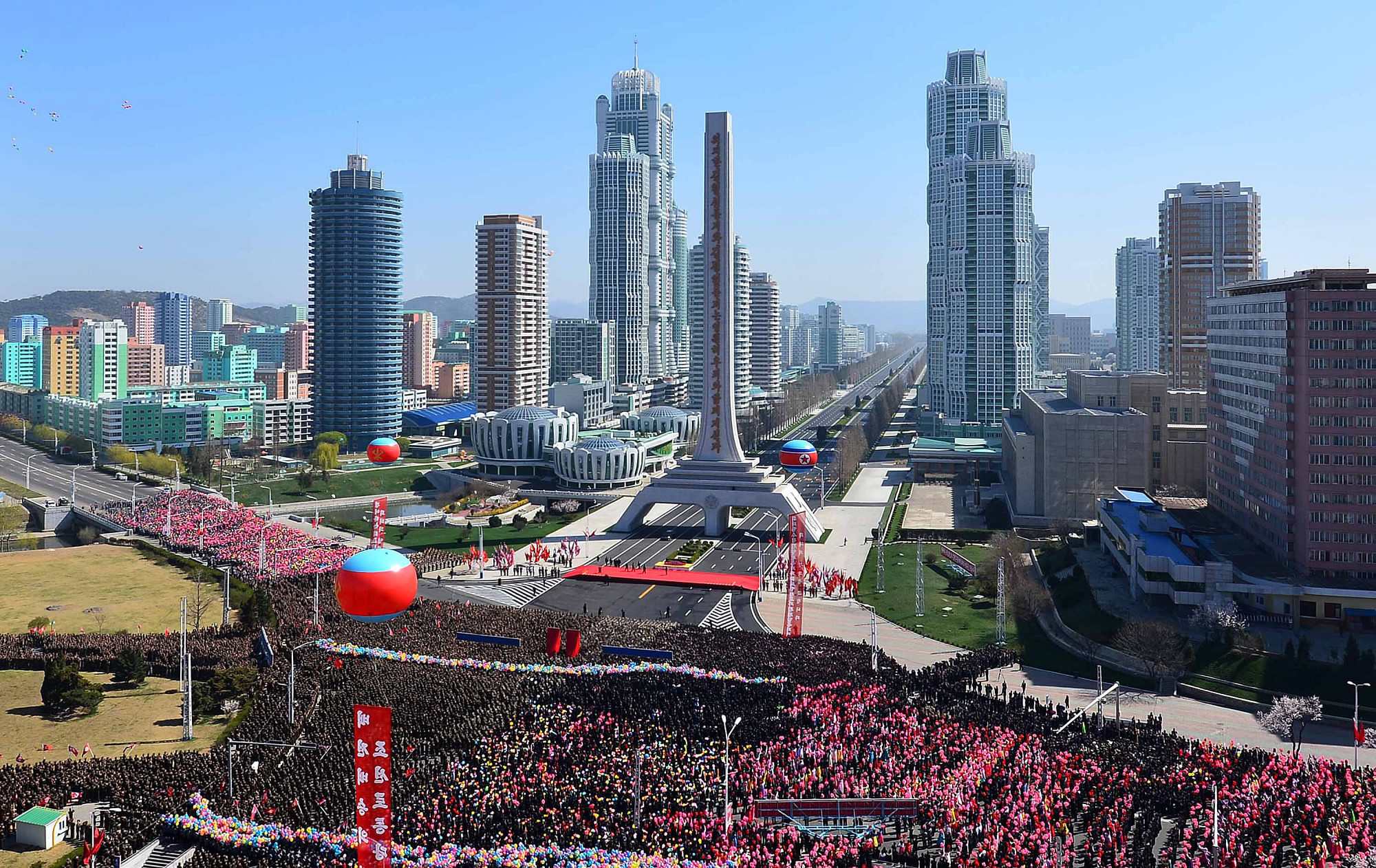
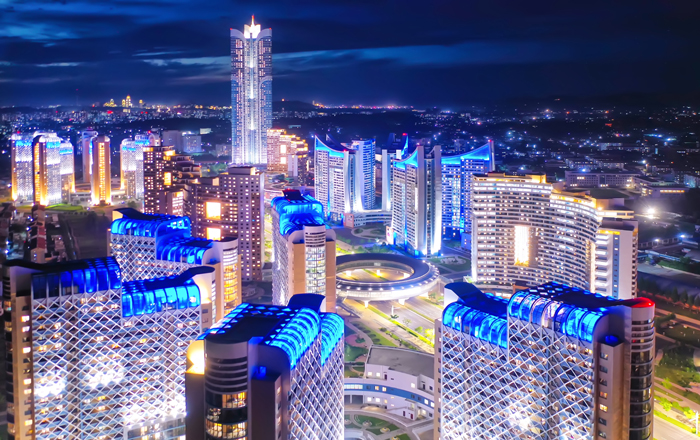
Pyongyang (Korean: 평양시; Hanja: 平壤市) is the capital of the Democratic People's Republic of Korea. Pyongyang is located on the Taedong River about 109 km (68 mi) upstream from its mouth on the Yellow Sea. Pyongyang is a directly administered city with equal status to the provinces of DPRK.
Pyongyang is one of the oldest cities in Korea.[1]
There are many prominent landmarks in Pyongyang, such as Juche Tower, Kim Il Sung Square, the Chollima statue, the Workers' Party of Korea founding monument, Pyongyang's Arch of Triumph, the Mansu Hill Grand Monument, and the Kumsusan Palace of the Sun. The Ryugyong Hotel, known for its pyramid shape, is also found in Pyongyang. In addition there are several institutions in Pyongyang, such as the Grand People's Study House, the Kim Hyong Jik University of Education, and Kim Il Sung University, as well as attractions such as Moranbong Park, Munsu Water Park, the Central Botanical Gardens, and the Central Zoo.[2]
History[edit | edit source]
The ancient capital of the legendary Dangun dynasty (2333 BCE) was located on the site where, according to legend, the modern city of Pyongyang was founded in 1122 BCE.[1][3] Pyongyang has been the capital of two ancient Korean kingdoms, Gojoseon and Goguryeo, and served as the secondary capital of Goryeo.
In the 1890s, Pyongyang was the site of the Battle of Pyongyang, during the invasion that eventually led to Japanese colonial rule. During the colonial rule of the Japanese, Pyongyang became increasingly industrialized.[3]
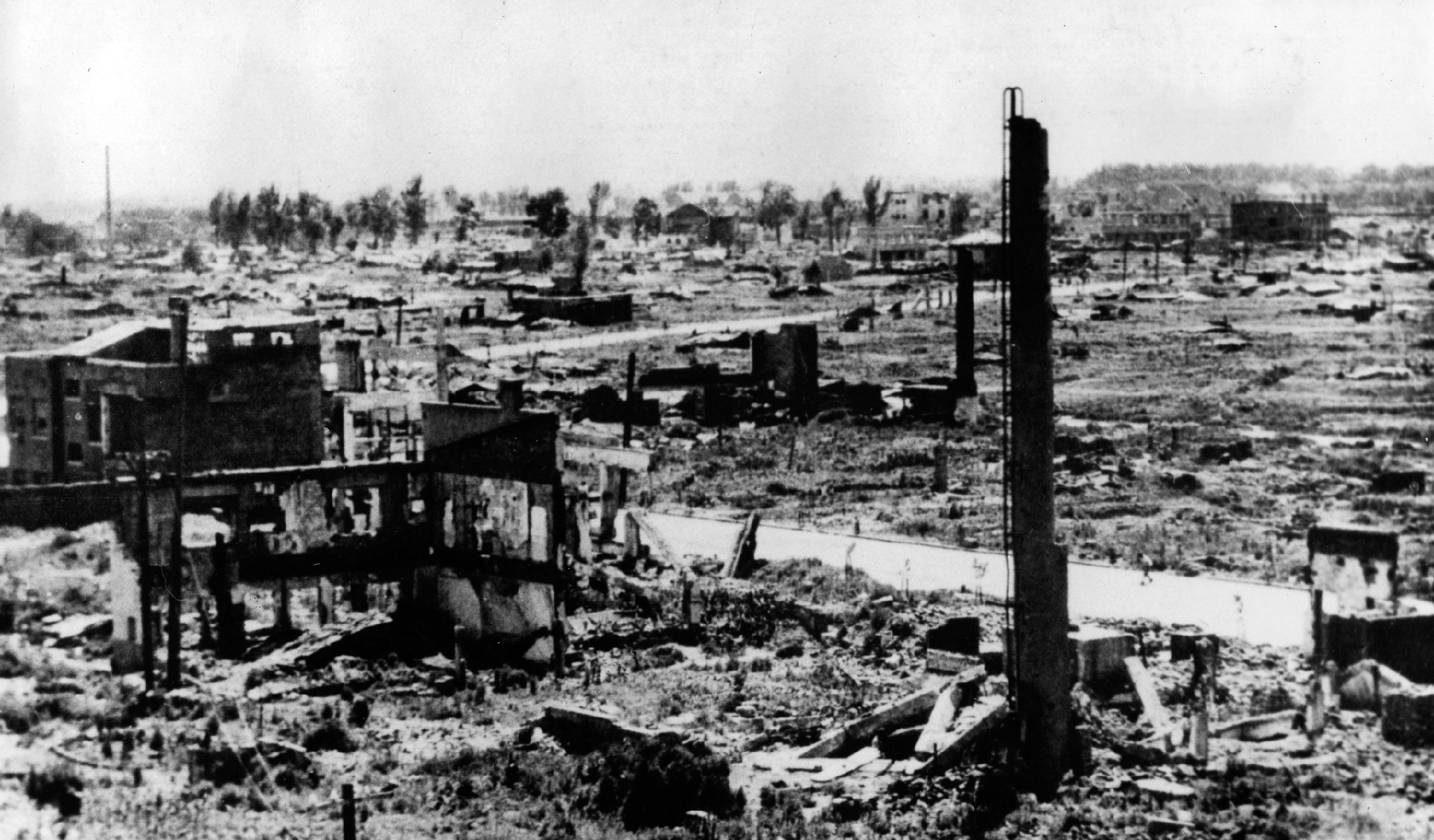
Korean War[edit | edit source]
Pyongyang was devastated during the Korean War, during the sustained aerial bombing by the United States of America. By the time of the armistice, an estimated 75 percent of Pyongyang's area was destroyed by the bombing campaign, which was part of a broader U.S. bombing effort throughout the country, in which conventional explosives, incendiary bombs, and napalm destroyed nearly all of the country's cities and towns.
Post-war rebuilding[edit | edit source]
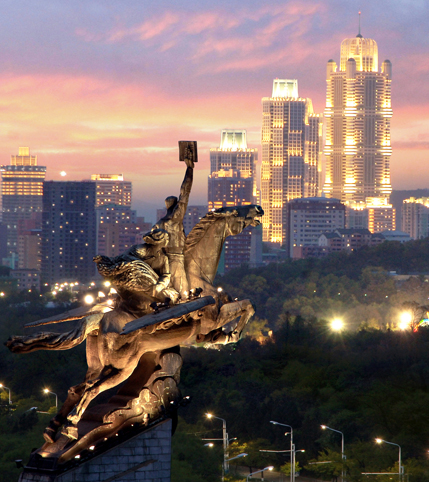
After the war, DPRK as a whole underwent a period of reconstruction. As Pyongyang was left in near-complete ruin after the war, urban planners were able to design a new structure for the city. Based on a 1953 plan designed by Kim Jung Hee, Pyongyang was planned as a one-million population city that would stretch from the Taedong River to the Potong River, with the density of city being planned as 20-25%. To resolve disparities between cities and to balance development between urban and rural area, the architects of Pyongyang aimed to set aside self-productive units within the city. In present times, Pyongyang continues to be planned based on a unit district system that combines the industrial and residential so that residents can both produce and consume their products.[6]
The design was intended so that Pyongyang be developed in a well-balanced way in contrast to any other capitalist cities in the world. Architects purposefully incorporated landscape features into the city. Both of Pyongyang's riversides were developed into major landscaped areas, and most major boulevards were heavily planted. Additionally, to maximize the effectiveness of labor and production for workers, planners created several leisure parks in the city, so that the public could have enough rest and recover before returning to production. In Pyongyang, most of the leisure parks were located close to historical or memorial areas. Meanwhile, the central part of the city was structured as a place for administrations and institutions. The main square, Kim Il Sung Square, is also located there, while Juche Tower is located directly across the river from the square.[6]
After the main focus on reconstruction in the 1950s, the architectural strategy of Pyongyang shifted in the 1960s, aiming for the expansion of the major boulevards and the construction of high-rise residential buildings along the boulevards, large-scale civic and cultural facilities, symbolic statues and squares, and including leisurely convenient facilities for foreigners.[6] The development strategy of DPRK as a whole in this period is known as the Chollima movement.[7]
Educational institutions[edit | edit source]
Pyongyang is the location of numerous universities and educational facilities specializing in various fields of study and training.
Universities[edit | edit source]
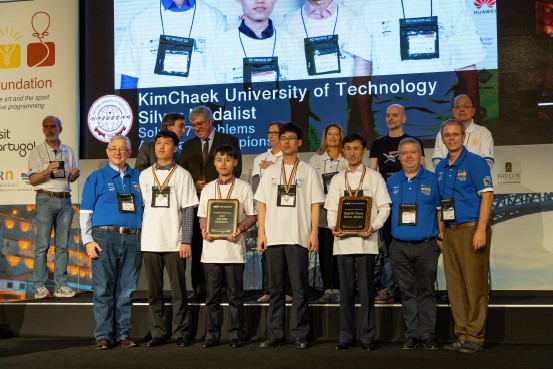
Kim-Il Sung University (Korean: 김일성종합대학; Hanja: 金日成綜合大學) was founded in 1946, soon after independence. It is DPRK's top university and includes a full range of faculties from the sciences to the arts and social sciences. During the war it was temporarily relocated to a site near Pyongsong City. Kim-Il Sung University hosts approximately 100 exchange students a year, the majority from China.[8]
Kim Chaek University of Technology (Korean: 김책공업종합대학; Hanja: 金策工業綜合大學) is one of DPRK's top technical universities. It has also been taking part in the International Collegiate Programming Contest for several years. It usually scores in the top 20. The university ranked in 8th position in the 2019 contest, which was held in Portugal. In doing so, it ranked ahead of Beijing and Tsinghua Universities of China, Oxford and Cambridge Universities of the U.K., Harvard and Stanford Universities of the U.S., and south Korea's Korea Advanced Institute of Science and Technology (KAIST).[9][10]
Kim Hyong Jik University of Education (Korean: 김형직사범대학; Hanja: 金亨稷師範大學) specializes in the training of teachers. Founded in 1946 as Pyongyang Teacher’s College (평양교원대학), its name was changed various times until receiving the current name, named after Kim Hyong Jik, Kim Il Sung’s father, who was a teacher.[11]
Pyongyang University of Foreign Studies (Korean: 평양외국어대학) offered summer programs to foreigners via Tongil Tours starting in 2016, offering three-week Korean language immersion courses at the university.[12]
Pyongyang University of Science and Technology (Korean: 평양과학기술대학) is the first and only privately-run university in DPRK, established via a contract between the Northeast Asia Foundation for Education & Culture and the DPRK Department of Education. The university opened in October 2010 and is located in Jonjin-dong, Rangnang District, Pyongyang. PUST has several foreign faculty members from China, the United States, Canada, the United Kingdom, and other parts of Europe. The foreign faculty teach in the schools of Agriculture and Life Sciences, Electrical and Computer Engineering, Foreign Languages, and International Finance and Management. The language of education at PUST is English, so all first-year students take intensive English classes to prepare them for participation in their major classes. Chinese is taught as a second foreign language during the third year of the undergraduate program. Since 2011, during October every two years PUST hosts an international conference called the International Conference of PUST (ICoPUST).[13][14][15]
Deaf and Blind Center of Pyongyang[edit | edit source]
The Deaf and Blind Centre of Pyongyang is one of various institutions serving deaf and blind people in DPRK, and is located in Moranbong District. It provides specialized education and opportunities to deaf and blind students and helps provide employment for deaf and blind adults, while also increasing awareness about people with disabilities in DPRK. The center teaches braille and sign language to young students. Deaf and blind students and adults also translate materials into braille and provide sign language videos for educational material to the local intranet and schools throughout the country.[16][17]
A kindergarten for the deaf is also available in Moranbong District. The project to create the kindergarten was funded by a small German non-profit Disabled Persons Organization.[16][18] A member of a delegation of the World Federation of the Deaf who visited the kindergarten described his impression of the kindergarten in a 2016 article for British Deaf News: "[W]e were fortunate to see the great strides made there. It was interesting to see such a rapid progressive model of education and to see how these deaf children were learning Korean Sign Language from teachers who are deaf. [...] It was impressive to see the interaction between the children and the teacher. Colin and I got involved and we had a laugh with them and it proved that when a child has sign language, the world becomes their oyster. They were so animated, it was wonderful."[18]
Grand People's Study House[edit | edit source]
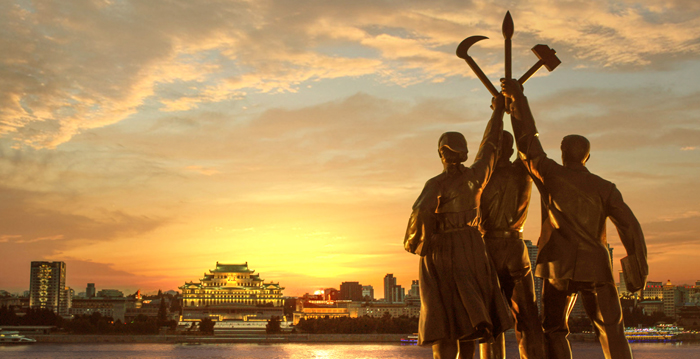
The Grand People's Study House (Korean: 인민대학습당; Hanja: 人民大學習堂) is DPRK's national library, built in 1982. It is located on Kim Il Sung Square, opposite to Juche Tower, with the Taedong River running in between.[19] The stated purpose of the library is to be a center of study of the Juche Idea, science, technology, and the arts. It also serves as correspondence university for continuing education and research. The various rooms include a music room, lecture theatres, and classrooms. Conversational language study sessions are commonly held at this library. Excluding holidays, the Grand People's Study House is open from 09:00 to 18:00 for general browsing. It is open 09:00 to 19:30 for specific lectures and class time with the exception of Saturday, Sunday, and holidays.[20]
Religious facilities[edit | edit source]
There are multiple religious facilities in Pyongyang serving different faiths as well as some being preserved historical sites. Some are recently built while others were built before the war (many of them having to be re-built after the war's devastation). Some facilities cater mainly to Pyongyang's expat communities, while others serve the local community as well as visitors, while others are oriented toward preserving sites of historical or cultural interest. Christian churches include the Protestant Bongsu, Chilgol and Jeil churches, as well as the Catholic Jangchung Cathedral, and the Orthodox Holy Trinity Russian Church.[21] The Ar-Rahman Mosque serves the Muslim community of Pyongyang.[22] Pyongyang also has Kwangbop Temple, a Buddhist temple that was re-built after the destruction of the war. Today, the temple is managed as a national heritage site according to the national heritage protection policy of the Workers' Party of Korea.[23]
Previously, Pyongyang had so many churches that it was sometimes known as the "Jerusalem of the East". These churches, like nearly everything else in Pyongyang, were annihilated in the Korean War carpet bombing campaigns perpetrated by the USA.[24] In the 2014 documentary People Are The Sky, a member of the congregation at Bongsu Church in Pyongyang spoke about her experience during the U.S. carpet bombing of the DPRK and its impact on the Christian community who suffered from the U.S. attacks:
There were many churches on Pyongyang. Actually, because there were so many churches, we called it the second Jerusalem. [...] After we were liberated, the People's Government was established. A lot of churches were born freely. After that we lived in peace. We were able to live in peace for the next five years. [Until the war broke out.] I believe those five years were our golden age. We attended church every week after school. But soon there was no church left because of the heavy bombing. Even during the worship service, the bombing killed a lot of people. When I think of that time, even now tears gather in my eyes. So many of my friends died. Then we heard that the U.S. was planning to drop the atomic bomb. We were threatened that we would all die and must go south. Because of that threat, a lot of my people headed south. Americans shot those people and killed them. So they killed, largely by bombing but also by shooting. They bombed us even during worship service. No churches were left in Pyongyang! Before the war, we thought Americans were angels from God, but after the war, we hated them.[25]
Churches[edit | edit source]
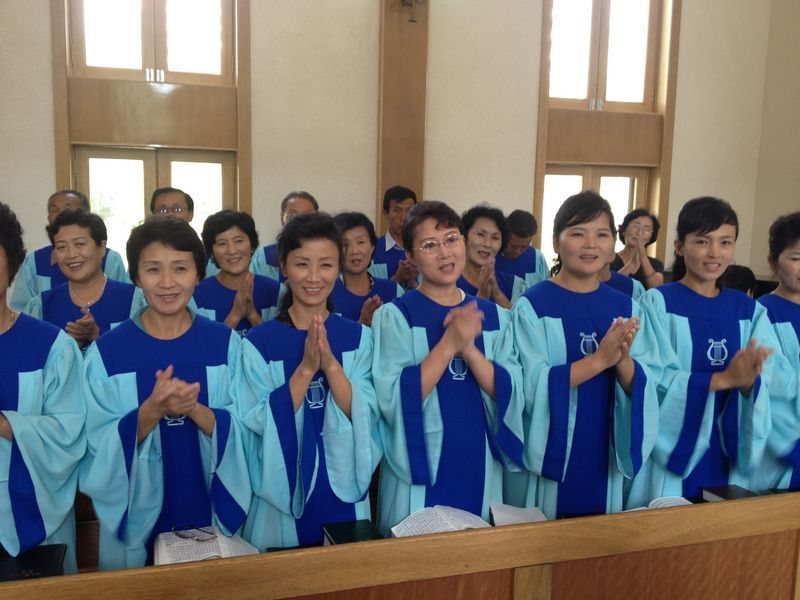
Chilgol Church is one of the oldest and most important protestant churches in Pyongyang, located on Liberation Street,[26] originally founded and built in 1899. In June 1950, the church was levelled during the war. Following the war, in 1989 it was rebuilt to fit the original style of the building. The church welcomes foreign residents, tourists, and local devotees alike. Officially there is a congregation of about 150 people that regularly attend services at the church. President Kim Il Sung's mother was also a patron of Chilgol Church.[27] Chilgol Church is in Mangyongdae District, on the west side of Pyongyang City, just off the massive Kwangbok Street and very close to the Xiangmanlou Chinese Restaurant and the Youth Hotel.[28]
Bongsu Church, also spelt Pongsu Church this is the largest church in Pyongyang. It was built and opened in 1988. Later, Bongsu Church was relocated, expanded, and rebuilt in 2008, with money donated from South Korean religious groups. It is open on Sundays, tourists are able to visit, all services are in Korean only, although Korean-English Bibles are available. Bongsu Church is located in the western part of Pyongyang, on a hillside above the Potong River and across from the Potong River Improvement Monument.[24]
The Jangchung Catholic Church was built in Songyo District, Pyongyang in March 1988 by devout Catholic believers. It covers an area of 2000 square metres and has a seating capacity of about 200.[29]
The Russian Orthodox church in Pyongyang was built in 2006. The church mostly serves the Russian expat community in Pyongyang. The decision to build the first Orthodox Church in the DPRK was made personally by Kim Jong Il on August 22, 2002, after his visit to the Church of St. Innocent Innokentiy of Irkutsk in Khabarovsk. In 2003, the Russian Orthodox Church accepted four students from DPRK to study at the Moscow Ecclesiastical Seminary (MES). The Church was built by Korean workers in two years at the expense of the DPRK budget. Bells, icons and church utensils were donated by the Russian Orthodox Church, and employees of the Russian Embassy to the DPRK helped in the construction of the church as well. Regular services at the Trinity Church are held every Saturday (the Night Service) and every Sunday (the Divine Liturgy).[30][21]
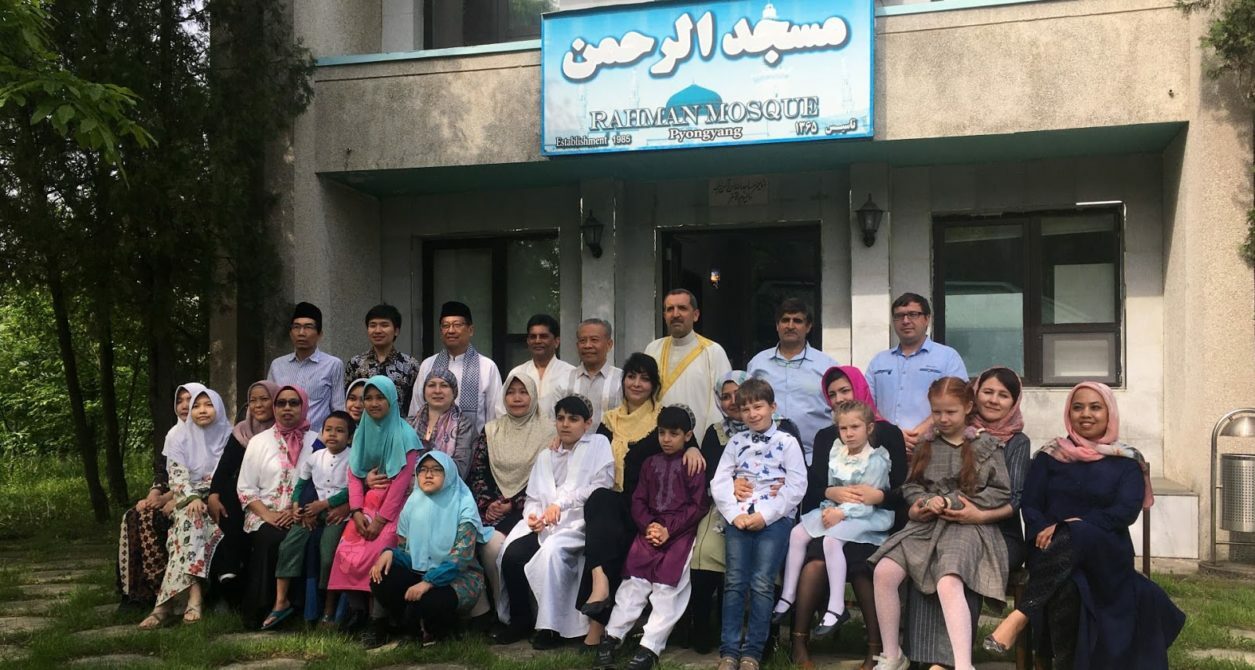
Ar-Rahman Mosque[edit | edit source]
Ar-Rahman Mosque serves the Muslim community of Pyongyang and is located on the grounds of the Iranian embassy, where expats of various countries can come to participate in the religious services.[22]
Kwangbop Buddhist Temple[edit | edit source]
Kwangbop Temple (Korean: 광법사) is a Buddhist temple that was destroyed by the US air raids during the war and later restored. Visiting the temple site in 1989, President Kim Il-sung gave an instruction on restoring the temple to its original state.[31] It was eventually restored in 1990.[32][33] Today, Kwangbop Temple is preserved and managed as a national heritage site according to the national heritage protection policy (Korean: 민족유산보호정책) of the Workers' Party of Korea.[23]
External links[edit | edit source]
- Video: 360° VR Pyongyang City Tour, 2016 July, uploaded to YouTube by Aram Pan. GoPro 4K version uploaded by Young Pioneer Tours. Description: "Produced with the exclusive permission from the DPRK, a 360° camera by Entaniya was mounted on top of a car and driven around Pyongyang. The video is over an hour long and because it's captured in 360°, each time you watch it will be a different experience as you can look around, up and down."
- Video: "'Enter Pyongyang', a time-lapse video of the North Korean capital". Uploaded by Koryo Tours, 2014. Features street scenes, monuments, building and subway interiors, inside of buses, and skate park footage.
- Video: "Pyongyang - streets in the city." May 2016.
- Video: "Night walk through the Ryomyong Street in Pyongyang". Filmed in 2018.
- Video: "Pyongyang Public Transport 평양 교통 (2019)". Features street scenes of Pyongyang with a focus on the public transportation.
- Video: "Visiting Pyongyang | Travel to North Korea" by DPRK Explained.
- Image: 360° virtual tour of the Tower of Juche Ideology. Description: "The image was captured during sunset, which is the most spectacular time to visit the tower." Posted by Aram Pan on DPRK360.com.
- Image: Unobstructed 360° view from Juche tower. Posted by Aram Pan on DPRK360.com.
References[edit | edit source]
- ↑ 1.0 1.1 “P’yŏngyang | National Capital, North Korea” Encyclopædia Britannica.
- ↑ “North Korea Travel Guide | Pyongyang Sights and Tourist Attractions.” 2017. Tongil Tours. June 23, 2017. Archived 2023-03-14.
- ↑ 3.0 3.1 “The Ultimate Pyongyang Guide.” Young Pioneer Tours, Accessed 10 Apr. 2023. Archived 2023-03-23.
- ↑ “Chollima Statue.” KFAUSA.org, Accessed 10 Apr. 2023.
- ↑ “The Chollima Statue | North Korea Travel Guide - Koryo Tours.” Koryogroup.com, 29 Jan. 2019, Accessed 10 Apr. 2023.
- ↑ 6.0 6.1 6.2 Yim, Dongwoo. “A Brief Urban History of Pyongyang, North Korea—and How It Might Develop under Capitalism.” The Architect’s Newspaper, 24 Aug. 2017, accessed 10 Apr. 2023. Archived 2023-01-19.
- ↑ "Rebuilding North Korea | The Chollima Movement EXPLAINED." DPRK Explained. YouTube. March 25, 2023. Archived 2023-04-01.
- ↑ “North Korea Travel Guide | Pyongyang Attractions | Kim Il Sung University.” 2018. Tongil Tours. January 8, 2018.
- ↑ Williams, Martyn. “Kim Chaek University Ranks 8th in International Programming Contest.” North Korea Tech - 노스코리아테크, 3 May 2019, Accessed 9 Apr. 2023. Archived 2022-10-05.
- ↑ Williams, Martyn. “Science and Technology Education in North Korea Enters the 21st Century.” North Korea Tech - 노스코리아테크, Accessed 9 Apr. 2023. Archived 2022-12-03.
- ↑ “North Korea Travel Guide | Kim Hyong Jik University of Education.” Tongil Tours. January 8, 2018. Archived 2023-03-5.
- ↑ “Study in North Korea | Pyongyang Korean Language Program.” Tongil Tours. June 8, 2019. Archived 2023-02-28.
- ↑ “About Us – Pust.co.” Pust.co. 2019. Archived.
- ↑ PUST. 2016. “Pust Stories: Mi Hyang.” YouTube Video. Archived 2023-03-23.
- ↑ highersites. 2014. “My Experience at PUST(North Korea)평양과기대에서의 체험(영어).” YouTube Video. Archived 2023-03-23.
- ↑ 16.0 16.1 “YPT Deaf & Blind Charity.” Young Pioneer Tours. September 25, 2020. Archived 2022-12-07.
- ↑ Young Pioneer Tours. “Pyongyang Centre for the Deaf and Blind.” YouTube Video. Archived 2023-03-23.
- ↑ 18.0 18.1 “Deaf Advances in North Korea.” British Deaf News. September 15, 2016. Archived 2023-03-24.
- ↑ “North Korea Travel Guide | Pyongyang | Grand People’s Study House.” Tongil Tours. June 23, 2017. Archived 2023-03-05.
- ↑ “Grand People’s Study House | North Korea Travel Guide - Koryo Tours.” Koryogroup.com. December 27, 2018. Archived 2023-03-23.
- ↑ 21.0 21.1 Dennison, Tariq. 2014. “Russian Orthodox Church in Pyongyang, North Korea (DPRK).” YouTube Video. Archived 2023-03-23.
- ↑ 22.0 22.1 Parker, Jaka. 2017. “Eid Al-Fitr in North Korea | Muslim in North Korea.” YouTube Video. Archived 2022-10-07.
- ↑ 23.0 23.1 “광법사.” May 15, 2022. DPRK Today. Archive.
- ↑ 24.0 24.1 “Bongsu Church | North Korea Travel Guide - Koryo Tours.” Koryogroup.com. May 4, 2020. Archived.
- ↑ Extremely Rare DPRK videos. “North Korean Christian Woman Tells What Happened to Christians in North Korea.” YouTube Video. Clip from Dai Sil Kim-Gibson's “People Are the Sky” (2014). Archived 2023-03-23.
- ↑ “Can You Go to Church in North Korea?” Young Pioneer Tours. January 24, 2019. Archived 2022-09-22.
- ↑ “Chilgol Church Pyongyang.” Young Pioneer Tours. April 24, 2020. Archived 2023-03-23.
- ↑ “Chilgol Church | North Korea Travel Guide - Koryo Tours.” May 4, 2020.
- ↑ “Jangchung Catholic Church in the DPRK.” 2013. KFAUSA.org. December 5, 2013. Archived 2023-03-23.
- ↑ "Orthodox Church of the Live-Giving Trinity in Pyongyang." Embassy of Russia to the DPRK. Archived 2023-03-23.
- ↑ “Kwangbop Temple.” DPRK Today. Archived 2023-03-23.
- ↑ “Exclusive Buddhist Temple Tour of North Korea | Uri Tours.” Uri Tours. October 21, 2013. Archived 2023-03-23.
- ↑ NatalieRevolts, DefendKorea. 2021. “Kwangbop Temple [DPRK Spotlight].” YouTube Video. Archived 2023-03-23.
